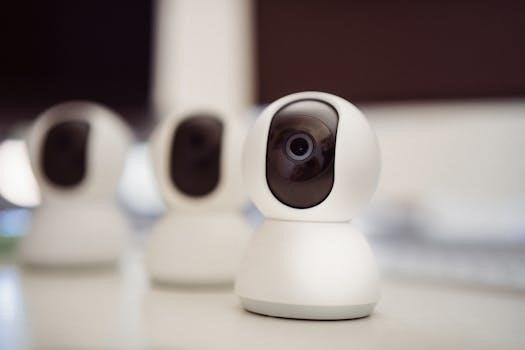Smarter Not Harder⁚ Dave Asprey’s Biohacking Guide

Dave Asprey, a renowned biohacker, introduces his approach in “Smarter Not Harder,” revealing the secrets of the body’s “MeatOS.” This system, naturally lazy, explains why traditional methods often fail. He provides a revolutionary plan to unlock human potential through biohacking techniques, focusing on working smarter, not harder, to achieve optimal health and performance.
In “Smarter Not Harder,” Dave Asprey challenges conventional wisdom surrounding health and wellness, moving away from the “no pain, no gain” mentality. He introduces a groundbreaking concept centered around optimizing the body’s natural tendencies rather than fighting against them. Asprey argues that the human body’s operating system, which he terms the “MeatOS,” is inherently designed for efficiency and laziness. This foundational understanding is crucial to his approach, as it suggests that excessive effort in exercise and rigid dietary restrictions may not always yield the desired results. Asprey’s new book advocates for a smarter approach that leverages biohacking principles to work in harmony with the body’s innate mechanisms. The core message is that achieving peak performance and well-being is not about pushing oneself to extremes, but about strategically using biological shortcuts to unlock greater energy and resilience. Through a practical and accessible guide, Asprey empowers readers to take control of their own biology, leading to lasting improvements without the constant struggle often associated with traditional health programs.
The Concept of MeatOS
Dave Asprey introduces the “MeatOS” as a central concept in “Smarter Not Harder,” describing it as the body’s inherent operating system. He posits that this system is fundamentally designed for laziness, prioritizing energy conservation and efficiency. This explains why conventional methods of health and fitness, which often involve rigorous exercise and strict diets, can be ineffective or unsustainable. The MeatOS, according to Asprey, is not something to be overcome, but rather a system to be understood and leveraged. It is the biological blueprint that dictates our energy levels, our metabolism, and our overall resilience. Instead of fighting against this innate tendency towards energy conservation, Asprey encourages a strategy of working with the MeatOS. By understanding the core drivers of this system, individuals can implement biohacking techniques that optimize its performance. This involves making strategic choices that support the MeatOS’s natural inclinations, such as focusing on smart workouts that maximize results in minimal time and making dietary adjustments that enhance rather than deplete energy levels. The MeatOS concept is a paradigm shift from traditional health advice, framing the body as a system to be hacked, not a machine to be forced.
Understanding the Body’s Natural Laziness
Dave Asprey’s “Smarter Not Harder” delves into the concept of the body’s natural laziness, a core principle he attributes to the “MeatOS.” This isn’t laziness in a pejorative sense, but rather an innate biological drive for efficiency and energy conservation. The body, according to Asprey, is wired to minimize exertion and maximize resource utilization. This inherent tendency explains why strenuous exercise and restrictive diets often fail in the long term; they run counter to the body’s natural programming. Understanding this biological inclination is crucial for developing effective biohacking strategies. The body’s preference for ease and efficiency is not a flaw; it’s an evolutionary advantage that has ensured survival for millennia. Rather than fighting against this natural laziness, Asprey suggests we should work with it. This involves identifying the triggers that activate the body’s energy conservation mode and learning how to manipulate them to our advantage; Instead of pushing the body to its limits, the goal is to optimize its performance by providing the right signals and stimuli. This includes implementing smart workouts, adopting strategic eating patterns, and utilizing therapies that reduce stress and enhance resilience. By understanding and respecting the body’s natural laziness, we can create sustainable health and wellness habits.
Why Traditional Methods Often Fail
Traditional approaches to health and fitness often falter because they clash with the body’s inherent “MeatOS,” as Dave Asprey explains in “Smarter Not Harder.” The conventional wisdom of “more is better” – longer workouts, stricter diets – ignores the body’s natural inclination toward laziness and efficiency. These methods often lead to burnout, frustration, and ultimately, failure. The body perceives intense exercise and severe calorie restriction as stressors, triggering survival mechanisms that slow metabolism and conserve energy. This creates a cycle where initial progress is followed by plateaus and rebound effects. Traditional diets often focus on restriction and deprivation, leading to cravings and unsustainable eating habits. Similarly, long, grueling workouts can cause inflammation and fatigue, hindering long-term adherence. Furthermore, these methods often fail to address the root causes of health issues, instead focusing on symptom management. Asprey argues that a deeper understanding of the body’s operating system is needed to create lasting results. The “Smarter Not Harder” approach prioritizes working with the body’s natural tendencies, not against them. It emphasizes optimizing the body’s functions through targeted strategies rather than relying on willpower and brute force. By working smarter, we can achieve our health goals without the need for unsustainable and exhausting methods.
Biohacking the MeatOS
In “Smarter Not Harder,” Dave Asprey introduces the concept of “MeatOS,” the body’s inherent operating system, and explains how to biohack it for optimal performance. Biohacking the MeatOS involves understanding its natural inclination towards laziness and using that knowledge to our advantage. Instead of fighting against the body’s natural tendencies with excessive exercise and restrictive diets, we can strategically manipulate its functions to enhance energy, stamina, and overall health; This includes employing techniques to optimize mitochondrial function, the powerhouses of our cells, thus boosting energy production. Asprey advocates for targeted interventions that address the root causes of dysfunction, rather than simply managing symptoms. This involves utilizing cutting-edge technologies, nutritional strategies, and lifestyle modifications to influence the body’s biochemistry and physiology. Biohacking the MeatOS also emphasizes the importance of reducing inflammation and optimizing sleep, both crucial for proper cellular function and repair. It is about working with your biology, not against it, to create sustainable and lasting results. By leveraging the body’s innate processes, we can achieve peak wellness with less effort and more efficiency. Biohacking the MeatOS provides a roadmap for achieving optimal health by understanding and working with the body’s natural systems.
The Core Principles of Smarter Not Harder
The core principles of “Smarter Not Harder,” as outlined by Dave Asprey, revolve around optimizing the body’s natural systems rather than forcing them into unnatural states. A central tenet is the understanding of the body’s “MeatOS” and its inherent tendency towards efficiency, often perceived as laziness. This principle advocates for working with this tendency, not against it, to achieve optimal results. Another principle emphasizes targeted interventions that address the root causes of health issues instead of merely managing symptoms. This requires a deep understanding of the body’s biochemistry and physiology, allowing for strategic adjustments to enhance performance. The concept of minimal effective dose is also vital, where interventions are tailored to produce maximum results with the least amount of effort. This approach values efficiency and precision over brute force. Asprey also highlights the importance of prioritizing recovery and stress management, understanding that these are crucial for sustained well-being. Furthermore, the integration of biohacking tools and technologies to enhance bodily functions forms a cornerstone of this approach. The principles promote a personalized approach to wellness, recognizing that each individual’s needs and responses are unique. Ultimately, “Smarter Not Harder” is about achieving lasting health by working in harmony with the body’s natural processes.
Eating Smarter
In “Smarter Not Harder,” Dave Asprey emphasizes “Eating Smarter” as a cornerstone of his biohacking approach, moving away from restrictive diets to focus on strategic nutrition. This principle involves understanding the impact of different foods on the body’s energy levels and overall performance, prioritizing nutrient-dense options over empty calories. A key aspect is identifying and eliminating anti-nutrients, substances that can hinder nutrient absorption and cause inflammation. This involves being mindful of food sensitivities and making informed choices based on individual needs. Asprey advocates for a diet rich in healthy fats, moderate protein, and controlled carbohydrates, focusing on quality over quantity. He promotes the consumption of whole, unprocessed foods, steering clear of artificial additives and sugars. The emphasis is on fueling the body with the building blocks it needs for optimal function, rather than simply focusing on calorie restriction. This approach includes practices like intermittent fasting and strategic meal timing to optimize metabolic processes. Eating smarter also involves paying attention to the body’s signals, such as hunger and satiety cues, promoting a more intuitive and sustainable approach to eating. Ultimately, the goal is to nourish the body effectively, enhancing energy, focus, and overall well-being.
Smart Workouts for More Energy in Less Time
Dave Asprey’s “Smarter Not Harder” philosophy extends to physical activity, advocating for “Smart Workouts” that maximize results while minimizing time investment. This approach challenges the conventional belief that more exercise equates to better results. Instead, Asprey emphasizes efficiency and effectiveness, focusing on short bursts of high-intensity training combined with strategic recovery. He highlights the importance of understanding the body’s natural limitations and avoiding excessive stress. Rather than grueling, lengthy workouts, he recommends targeted exercises that stimulate muscle growth and metabolic function. This involves incorporating varied movement patterns, such as resistance training, interval training, and mobility work, to promote overall fitness. Asprey stresses the importance of proper form and technique to prevent injuries and optimize results. The focus is on quality over quantity, ensuring that each movement is purposeful and effective. Smart workouts also include recovery strategies, such as proper hydration, nutrition, and sufficient sleep, to support muscle repair and growth. By adopting this approach, individuals can experience increased energy levels, enhanced strength, and improved overall fitness without spending countless hours in the gym. The core principle is to work with, not against, the body’s natural tendencies for optimal health and performance.
Strategic Therapies for Stress Reduction
In “Smarter Not Harder,” Dave Asprey addresses the pervasive issue of stress, presenting strategic therapies designed to effectively reduce its impact on the body and mind. He emphasizes that managing stress is crucial for overall well-being and performance. Unlike traditional approaches that may involve lengthy meditation sessions or excessive relaxation techniques, Asprey advocates for biohacking strategies that provide quick and efficient stress relief. These therapies include the use of specific light frequencies to influence mood and sleep, as well as the application of targeted sound frequencies to promote relaxation. Asprey explores the benefits of grounding techniques, such as walking barefoot on natural surfaces, to reduce inflammation and promote calm. He also highlights the importance of optimizing sleep patterns, advocating for consistent sleep schedules and proper sleep hygiene. Furthermore, Asprey discusses the power of breathwork exercises to regulate the nervous system and reduce anxiety. He encourages incorporating these techniques into daily routines for consistent stress management. The book emphasizes that stress reduction should be viewed as a proactive process, rather than a reactive one. By employing these strategic therapies, individuals can effectively manage stress, enhance resilience, and improve their overall quality of life, without requiring significant time or effort.

Boosting Resilience Through Biohacking
Dave Asprey’s “Smarter Not Harder” delves into the concept of building resilience through targeted biohacking techniques, moving beyond the traditional understanding of resilience as simply “toughing it out.” Asprey introduces methods designed to strengthen the body’s natural ability to adapt and recover from stressors. He emphasizes that resilience isn’t a fixed trait but a skill that can be developed. The book explores how specific environmental factors, like light and temperature, can be manipulated to enhance resilience. Asprey discusses the importance of optimizing mitochondrial function, the powerhouses of cells, to improve energy levels and stress tolerance. He advocates for strategic use of supplements and nutrients that support the body’s natural defense mechanisms. The book highlights the role of intermittent fasting in promoting cellular repair and adaptation, thereby enhancing resilience. Asprey introduces the concept of hormesis, the idea that small doses of stressors can make the body stronger. He explores the benefits of cold exposure, such as cold showers or ice baths, to strengthen cardiovascular function and improve stress management. Furthermore, Asprey emphasizes the importance of emotional resilience, offering biohacking techniques to manage stress and improve mental fortitude. By incorporating these strategies, individuals can effectively boost their resilience, enabling them to face challenges with greater strength and adaptability, and ultimately, thrive in demanding environments.
Practical Application of the Book’s Teachings

In “Smarter Not Harder,” Dave Asprey provides not just theories, but also practical ways to apply his biohacking principles in everyday life. The book guides readers on how to implement smarter eating strategies, focusing on nutrient-dense foods that support the body’s natural functions without the need for restrictive diets. Asprey details specific workout routines that are designed to maximize results in minimal time, emphasizing the importance of efficiency over grueling hours at the gym. He advocates for incorporating strategic therapies for stress reduction, such as meditation and grounding techniques, to help readers manage their mental and emotional well-being. The book offers actionable advice on how to optimize sleep patterns for better recovery and cognitive function. Asprey provides guidance on how to use light therapy to regulate circadian rhythms and improve energy levels. He also offers practical tips on how to use technology to track progress and personalize biohacking strategies. Asprey encourages readers to experiment with different approaches to find what works best for their individual needs. Furthermore, the book emphasizes the importance of consistency, advocating for small, sustainable changes that can lead to long-term health improvements. By following the practical advice in “Smarter Not Harder,” readers can effectively apply biohacking techniques to enhance their overall well-being and achieve their health goals.
Achieving Lasting Health
Dave Asprey’s “Smarter Not Harder” emphasizes that achieving lasting health isn’t about short-term fixes or extreme measures, but rather about understanding and working with the body’s natural systems. The book promotes a sustainable approach to wellness, focusing on optimizing the body’s “MeatOS” for long-term benefits. It encourages readers to move away from the traditional “more is better” mindset, instead embracing a more efficient and strategic path towards lasting health. Asprey advocates for making small, consistent changes to diet, exercise, and lifestyle that build upon each other over time. He emphasizes the importance of listening to the body’s signals and adjusting strategies as needed, recognizing that everyone’s needs are unique. The book encourages readers to prioritize nutrient-dense foods, smart workouts, and effective stress-management techniques, which collectively contribute to long-term well-being. It provides practical guidance on how to create a personalized biohacking plan that aligns with individual goals and lifestyle. Asprey highlights the significance of consistent effort, rather than sporadic bursts of intensity, for achieving lasting health improvements. Furthermore, he stresses the importance of sleep, recovery, and emotional well-being as foundational aspects of a sustainable health strategy. By following the principles outlined in “Smarter Not Harder,” readers can create a pathway toward enduring health, not just temporary improvements.

Dave Asprey’s Approach to Wellness
Dave Asprey’s approach to wellness, as detailed in “Smarter Not Harder,” is rooted in the concept of biohacking—understanding and manipulating the body’s systems for optimal performance. He challenges conventional wisdom that equates health with strenuous workouts and restrictive diets, arguing that our bodies, or “MeatOS,” are naturally designed for efficiency. Asprey advocates for a personalized approach, recognizing that what works for one person may not work for another. His methods focus on identifying and addressing the root causes of health issues rather than merely treating symptoms. This involves strategic interventions in nutrition, exercise, sleep, and stress management to enhance overall well-being. He emphasizes that small, consistent changes can produce significant, long-lasting results. Asprey encourages readers to become active participants in their own health journey, empowering them with knowledge and tools to optimize their biology. He promotes the use of technology and scientific research to inform wellness practices. His approach is characterized by a continuous learning and adaptation process, where individuals are encouraged to experiment and fine-tune their biohacking protocols based on personal feedback and results. Asprey’s philosophy centers around the idea that everyone has the potential to achieve peak health and performance by understanding and working with their body’s unique needs.